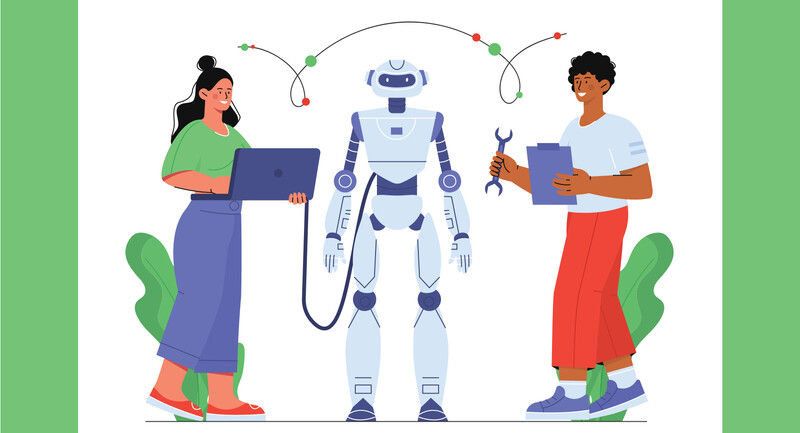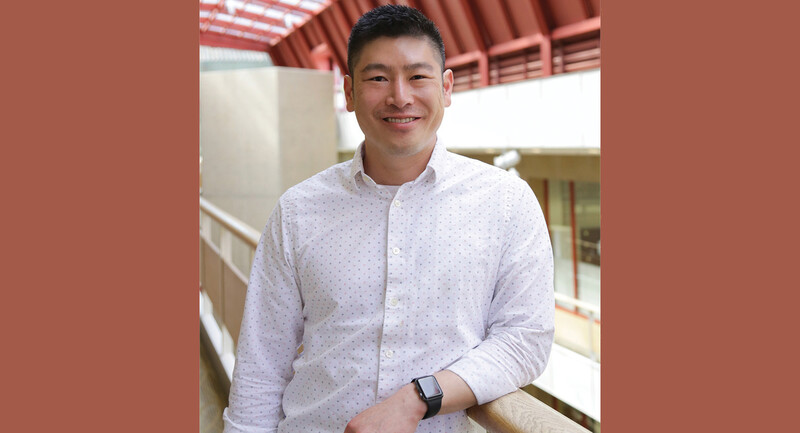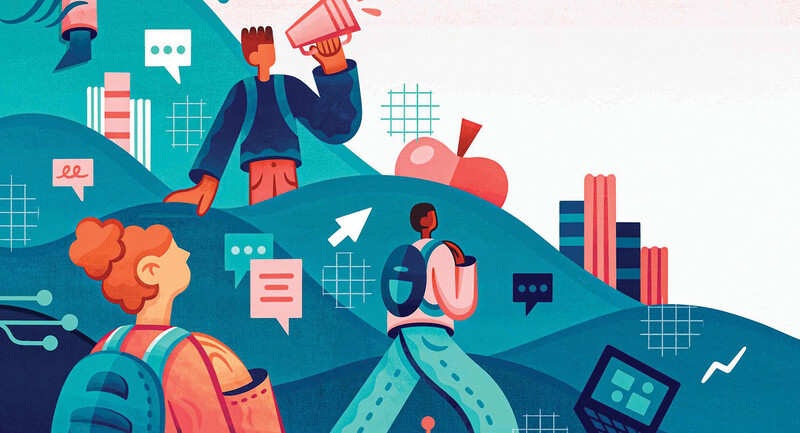I used to hate technology. I used to tell my high schoolers that smartphones were going to be the end of humanity. The idea of reading novels on a device, texting instead of talking, or friendships burgeoning online instead of in person sounded more like the end of something special rather than the beginning of something revolutionary. So bringing more tech into my high school English classroom was not a big priority. Sure, I appreciated the way my LCD projector and laptop made for better presentations and flexible workspaces, but I wasn't looking for more.
Then, in the fall of 2014, as I worked on our district's personalized learning committee, I was asked to consider piloting a blended class, one that would use a digital platform and flexible schedule to offer "anytime" learning. At first, I shook this off as a ridiculous notion. Creative writing and Chromebooks? My class lived in messy notebooks, half-chewed pencils, and dog-eared paperbacks. We sat in the grass and talked about poetry. We didn't need technology. I shared my doubts with our chief academic officer, but she didn't give up: "Jen, trust me … you'll love it."
Before committing, I explored the possibilities of personalization, of giving my creative writers a chance to write when their voice called to them and not simply during a prescribed 47-minute time slot during the school day. I took a second look at how technology could influence my classroom. What I found, to my surprise, was a way to manage the design of my ideal learning environment.
For years, I'd been photocopying and hand-binding giant course guides, jammed with every potential writing prompt, learning activity, and student sample I thought I might need. I liked handing my students a guidebook on the first day of the semester that offered choices and a clear pathway for where we were going. But keeping the choices flexible, accessible, and personalized was difficult. Every time I had a new idea, noticed that a student needed something beyond my expectations, or wanted to provide more choices, someone had to wait. Wait to access the resources. Wait to hear my instruction.
I soon realized that working on Canvas, the digital learning management system we were exploring, would allow my students to lead their own learning and allow me to better support them in the moment. If I had a cool idea on Sunday at 10:00 p.m., I could bring it in the door on Monday at 7:00 a.m. So I took the leap and became one of the district's teachers to pilot a blended learning environment.
Life in Pilot Land
At first, everyone was hesitant. Students weren't sure they wanted to take a class where they didn't see their teacher every day. Parents worried that their children wouldn't follow through with the workload. Administrators were concerned about accounting for students who had the freedom to move about the building or leave campus on blended days. It was a risk.
We had to get comfortable and, truthfully, that was messy. As a school, we weren't used to giving students the freedom to choose their learning spaces, so no one knew what to do. Those first several weeks, students would pop their heads in my doorway on blended days, questioning, "I don't have to come to class today?" Or "I can meet with my biology teacher today?" Or "I can write at Starbucks?" And the answer was always "Yes."
Our district started small, testing out Canvas and Chromebooks in just my high school. There were four of us in the pilot teacher group, in four different departments: health, English, business, and engineering. We were excited and motivated, but also not sure what to do. How would we structure our classes? To balance time spent leading direct instruction with time for students to work independently, we established a general ratio—60 percent in-class face-to-face time to 40 percent online learning. But figuring out how to organize the instruction was a challenge. My curriculum hadn't changed, but the way I presented it had. So, I started asking myself, If I´m requiring students to meet in class today, what am I offering them that they can't do on their own? Why do they need me? This became the measuring stick for my lessons. If my lesson wasn't engaging enough to include collaboration, personal conferencing, or community building, then it wasn't worth my students' time. I had to dig in and offer more.
With less in-class time, our face-to-face interactions became more focused and valuable. We wrote rolling short stories and community poetry via Google Docs, designed digital comic strips, and role-played to understand point of view. We shared our work aloud, and students became the teachers, leading mini-lessons to inspire their peers' writing. On blended days, students chose their own paths, accessing curated materials and selecting from a menu of writing activities I'd made available on Canvas. They completed assignments in the order they preferred and in the time and place they desired.
For me, the best part was the student consultation. While students engaged in their learning paths, selecting writing prompts and skill work that suited their interests and needs, I suddenly had more time to conference, to sit next to my writers and share suggestions and answer questions. In turn, my students began leaning on one another, meeting together on blended days to share their writing and garner feedback. I no longer needed to schedule peer editing. We weren't just a writing class: we had grown into a writing community.
As the other pilot teachers experienced similar success, district leaders made plans to expand blended learning. However, they knew that some teachers would embrace the challenge, others would not, and many would fall somewhere in between. The district needed to have a better way to talk about technology in our classes—a common language to ground our work.
Down the Rabbit Hole
But let's go back a minute to 2014. I was not alone in my hesitations about embracing technology. Sure, a small group of curious teachers in our district's middle and high school were folding tech into their classrooms with ease. But for every early adopter, there were a handful of other teachers shying away—because of hesitation, indifference, or conscious resistance. Teachers who opt out of tech often talk about it as a "required initiative" or "just one more passing trend." But technology is not a way of doing things. It's not a curriculum or philosophy. It's a tool that students use every day in their personal lives and that we as educators must meaningfully infuse into their academic lives.
Students need their teachers to believe technology integration is valuable. Damian Bebell and Rachel Kay note that "It is impossible to overstate the power of individual teachers in the success or failure of 1:1 computing" (2010, p. 47). Teachers also need to shift the learning dynamic in their classrooms. Research finds that 1:1 laptop programs may simply amplify existing teaching practices—for better or worse (Groff, 2013, p.15). The success of technology integration correlates with who drives the learning: teachers or students. Successful teaching places students in the driver's seat. This is why a teacher's approach is so significant. As ed tech researcher Amina Cviko and colleagues explain:
Teachers who hold constructivist beliefs reflecting a pupil-centered approach to teaching and learning have a positive effect on integrated classroom use of technology, whereas teachers holding teacher-centered approaches to teaching and learning negatively influence integrated technology-use in the classroom. (2012)
When adding technology to the classroom, we need to consider an instructional framework that supports the transformation of learning. Without a guiding framework, ed tech discussions can take many twists and turns that often have little to do with student learning.
Begin at the Beginning
Though our district began organically, piloting blended learning without a framework in place, it didn't take long to realize something was missing. We needed a cookbook, a guide for concocting engaging, fulfilling experiences, sure to wow even the pickiest of learners. We needed a way of envisioning technology that didn't treat it like "just one more thing."
For years, the two main technology integration frameworks used in schools have been the TPACK model and the SAMR model. Both models connect technology with useful application. TPACK defines the ideal place for teachers as in the center of technological knowledge, pedagogical knowledge, and content knowledge. SAMR focuses more on the individual student using the technology by describing four levels of integration: (1) substitution of technology for analog methods, (2) augmentation of analog tasks with digital means, (3) modification of activity design and function using technology, and (4) redefinition of tasks in a format not possible without the technology (Magana, 2017). Though SAMR is much more user-oriented than TPACK, the model itself was not specifically designed for education: "While it articulates a conceptual framework for the use of technology tools, there is no clearly defined context for that technology use; the SAMR model might just be as applicable to teaching, typesetting, or trench digging" (Magana, 2017, p.19).
Our district, however, was looking for a technology model that would truly embrace the context of the classroom. And so after extensive research, we landed on a third model—Sonny Magana's T3 Framework. Better suited to our needs, this model combines the user-oriented nature of SAMR with the specific educational context addressed in TPACK. In the T3 Framework, students' use of technology is scaffolded through three phases: (1) Translational, (2) Transformational, and (3) Transcendent.
In the Translational phase, similar to SAMR's substitution phase, students use technology to automate tasks, work efficiently, and consume materials digitally (Magana, 2017). Though this stage is relatively low value, the impact on saving time and increasing ease of access to resources makes it useful to teachers and students.
Higher-value tech use is described in the second stage: Transformational technology use "gives rise to dramatic or substantive changes in both the task to which the technology tool is applied and the person enacting the task" (Magana, 2017, p. 38). For example, students in a blended learning environment might build a website that highlights their research or screencast a slideshow they've built to explain concepts in a tutorial for peers. When technology is transformational, it invites students to design their learning and encourages work that contributes to others' learning.
At the highest stage, Transcendent technology use involves inquiry-based learning and social consciousness, asking students to "leverage readily available technologies not only to become their own knowledge cartographers but to contribute something of value for the benefit of the planet and its people" (Magana, 2017, p. 68). At this stage, within a blended learning environment, students research and problem-solve authentic conflicts by accessing vast digital resources and communicating with peers and experts across the globe. They share their findings with relevancy and build videos, websites, and tools to serve a learning need for those outside their classroom walls.
By adopting the T3 Framework, our district has been better able to guide teachers in the transition to blended learning; expand their ideas about what technology can do for their students; and provide a structure to talk about technology with our staff, students, and community. With a framework in place, we have been able to create a cohesive response to the questions raised about the value of technology in classrooms.
Very Few Things Are Impossible
Since the day our chief academic officer encouraged me to pilot a blended learning class, the program has grown tremendously. Our district currently offers 15 high school blended learning courses, ranging from geometry to art history to freshman English—and we plan to add more options next year. Blended learning is now being rolled out at the middle school level, and we are working with our elementary schools to determine the best way for them to enhance learning in their classrooms with technology.
On blended learning days, students at Yorkville High School have the option to do their work on or off campus. Here, they take advantage of one of the school's flexible learning spaces.
Fast forward to a year after my conversation with the personalized learning committee. Fast forward to 27 juniors and seniors reading their written work aloud to their peers in our first coffeehouse class, held at Panera during the school day. The writing I heard was rich, developed, and nuanced. My writers were finding time and space to write on their own schedules, following their own bouts of inspiration. We had fallen in love with the flexibility and accessibility of blended learning.
I still have concerns about the balance of technology in our lives, but I also see the power of tech to change the way students access learning. We have an opportunity at this critical juncture of creative possibility and technological actuality to design a paradigm of responsible technology use for our students, one that will propel them into their futures with a strong sense of both self and space. In my blended classroom, technology is a tool, not a vehicle. Relationships remain our top priority. We sit together in pods, filling the classroom simultaneously with the sounds of tapping keys and conversation. We start every in-class day with five minutes of mindfulness (meditation, coloring, riddles, or reflections), unplugging and re-centering. We play music and share snacks, keeping the real world more important than the digital world.
As we infuse technology further into students' lives, we must hold tight to the fact that personal relationships, face-to-face interactions, and quiet reflection will always be essential to a happy life—and that the convenience and excitement of technology should enhance—but never outweigh—the value of authentic human experiences.








